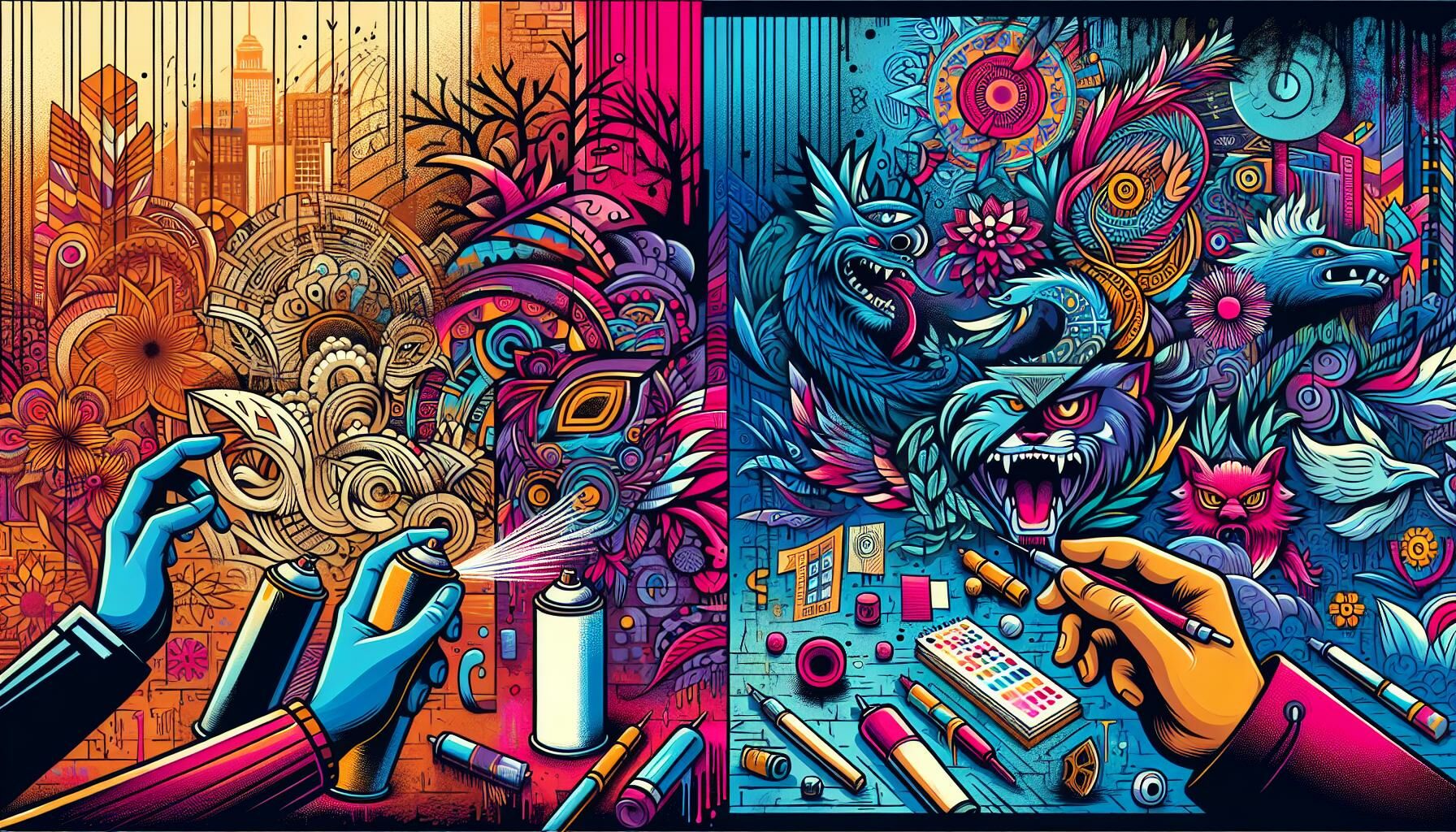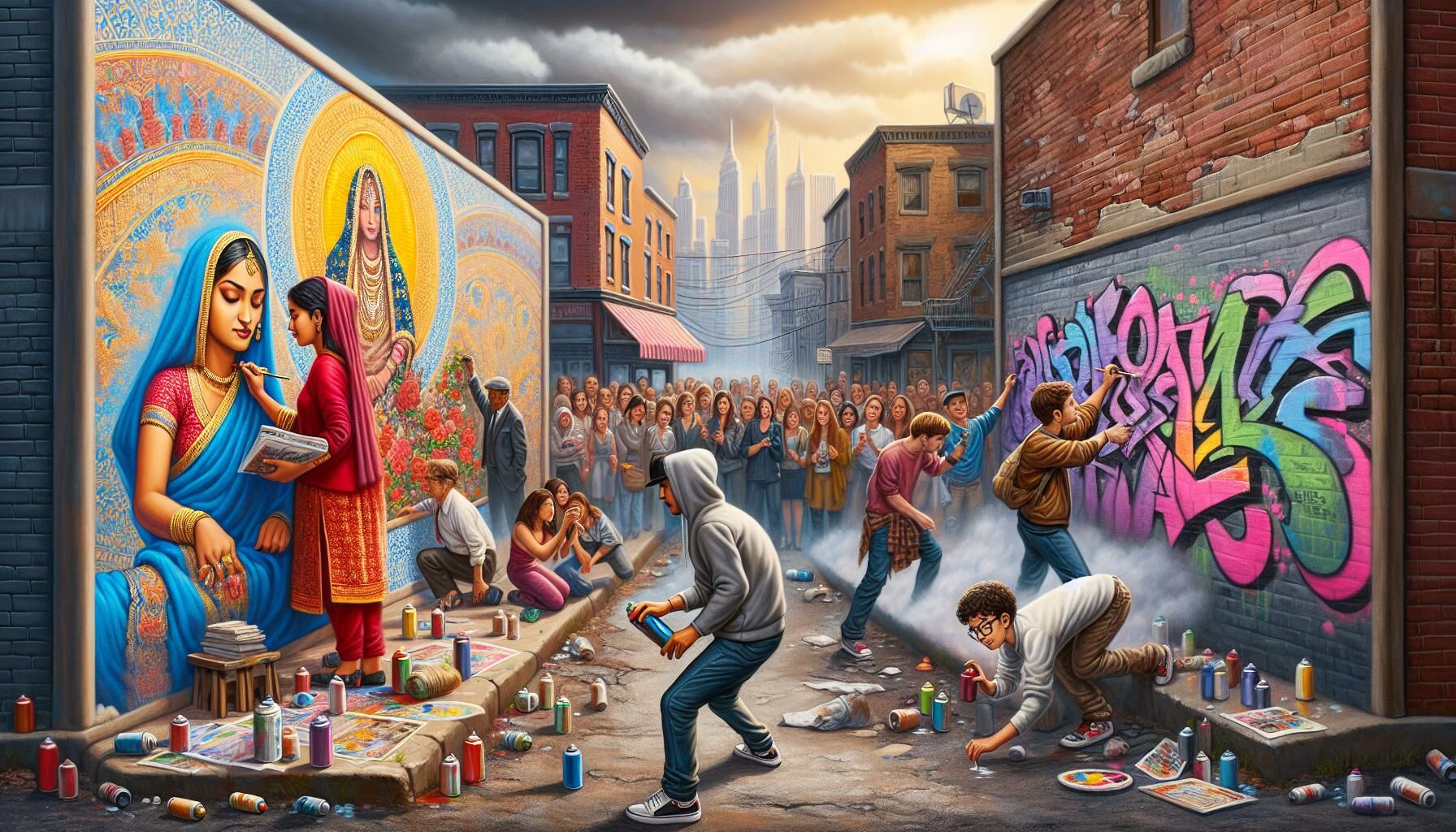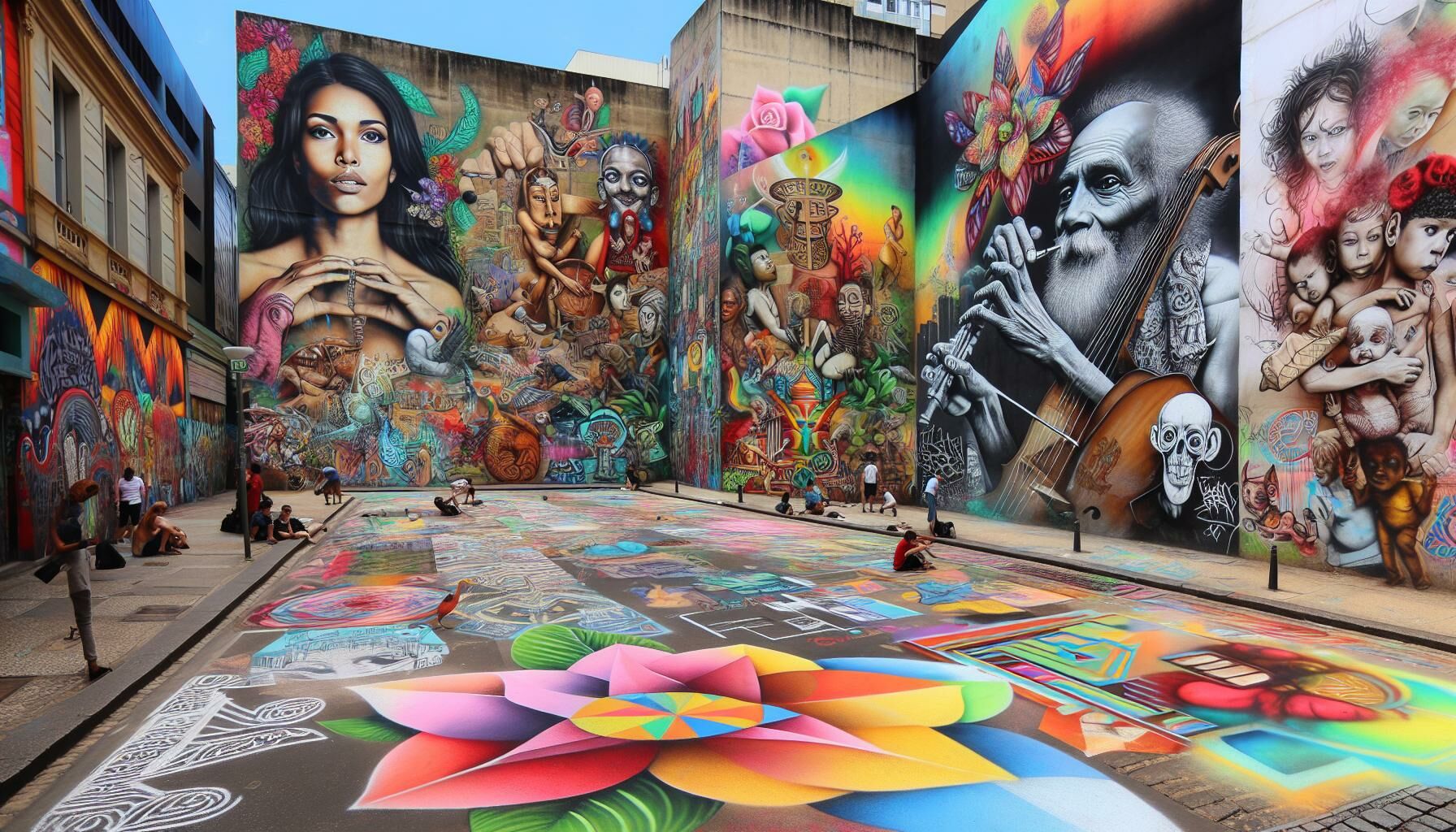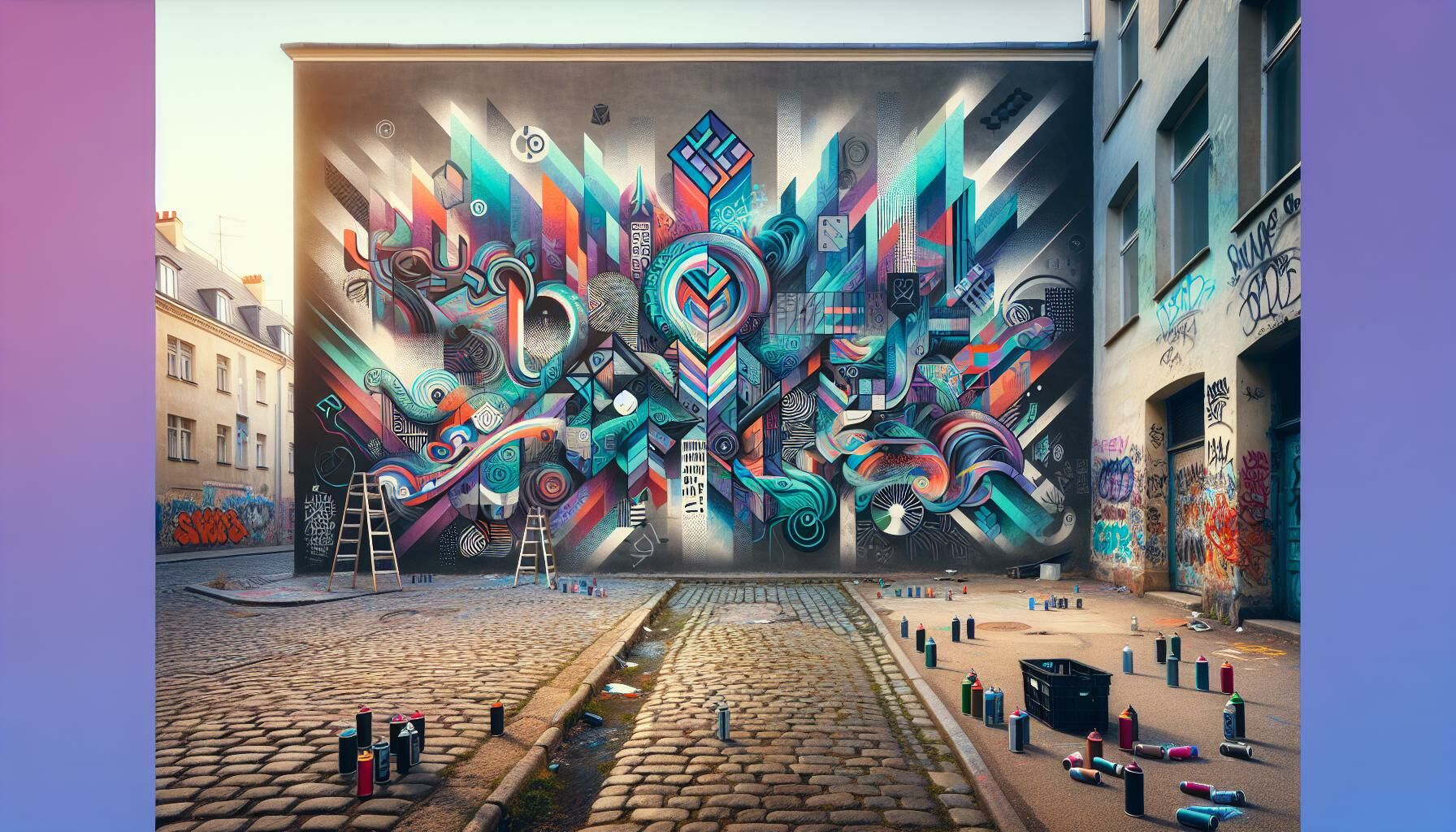Street art vs graffiti: From vandalism to fine art

Navigating the vibrant world of urban art, one often stumbles upon the intriguing debate of street art versus graffiti. Both forms share the canvas of city walls, yet they dance to different rhythms of expression and legality. This discussion isn’t just about art; it’s about understanding
Characteristics of street art and graffiti
Street art and graffiti vary in their characteristics, not just in legality and public perception, but also in their intrinsic qualities and intentions. Street art is typically image-based, encompassing a diverse range of mediums and techniques, such as murals, stencils, sticker art, and installations. It’s inclusive, aiming to engage with a broad audience, often weaving in themes of social activism, beauty, and community.
Graffiti, on the other hand, is predominantly word-based. It centers around the art of lettering, with artists exhibiting their skill in creating elaborate typographic artworks. Although it can also carry social and political messages, the essence of graffiti is more aligned with the act of marking territory and asserting identity within the urban jungle. The use of spray paint, markers, and etching tools is characteristic of graffiti, revealing a raw and edgy side to urban art.

Legal perspective
From a legal standpoint, the distinction between street art and graffiti is significant. Street art often exists within the bounds of the law, with artists typically gaining permission to transform spaces with their creative visions. This legal sanction not only legitimizes street art but also encourages collaboration between artists, property owners, and city officials, leading to projects that enhance public spaces and community identity.
Graffiti, under its unsanctioned nature, frequently falls into the realm of illegality. The act of creating graffiti without the property owner’s consent is considered vandalism under the law, a fact that has cultivated a negative reputation for graffiti among the general public and authorities alike. Despite this, the debate around graffiti’s status as art or vandalism continues to be a subject of discussion, reflecting the complex relationship between artistic expression, property rights, and societal values.
The interplay between street art and graffiti within urban environments creates a dynamic tapestry of visual communication, each with its unique flair and underlying ethos. As cities evolve, so too does the dialogue between these two forms of expression, highlighting the ongoing redefinition of public space and art in the contemporary world. Belonging among residents. Moreover, street art has become a crucial tool for social commentary, offering artists a platform to address pressing issues and engage with the public on a massive scale. Through the colourful and dynamic visuals scattered across city walls, street art continues to influence urban development, turning cities into open-air galleries that celebrate creativity and diversity.
Artists and key figures
Famous street artists
In street art, luminaries have emerged, pushing the boundaries of what can be created in public spaces. Artists such as Banksy, hailing from the UK, have not only become household names but have also ignited global discussions about art, politics, and social issues through their impactful imagery. This kind of art, often laden with deeper meanings and societal commentaries, has drawn the attention of art enthusiasts and critics alike. Banksy’s distinctive stenciled pieces, strategically located in various cities around the world, engage the public in a visual dialogue that transcends traditional gallery spaces.
Another pioneering figure in the street art scene is Jean-Michel Basquiat, whose roots in New York City’s vibrant art movement of the late 20th century allowed him to transition from street-level creativity to acclaimed gallery exhibitions. Basquiat’s work, known for its raw, emotive energy and bold depiction of themes such as race and identity, underscores street art’s profound influence on mainstream art discourse.


Notable graffiti writers
Graffiti, often seen as the more rebellious cousin of street art, boasts its legends. In major urban centers such as New York City and Philadelphia, graffiti “writers” like Keith Haring began their ascent to fame by transforming the subway experience with their dynamic, animated imagery. Haring’s work, characterized by vibrant, simplistic figures, brought a new level of visibility to graffiti, earning him a spot in the annals of art history.
The Seventh Letter Crew, a conglomerate of over 100 members based in Los Angeles, showcases the collaborative spirit within the graffiti community. This group, known for its collective art projects, is a testament to graffiti’s enduring appeal and the tight-knit community it fosters. They’ve skillfully navigated the legal landscape to share their vibrant, thought-provoking pieces with a wider audience, challenging perceptions of graffiti as mere vandalism.
Collaboration between street artists and graffiti writers
The intersection of graffiti and street art is where some of the most exciting collaborations have taken place, blurring the lines between two once distinctly separate disciplines. Artists from both backgrounds have come together, leveraging their unique skills and perspectives to create pieces that are more impactful and encompassing than could be achieved solo. These collaborations highlight the evolving landscape of urban art, where expressive forms and messages converge to spark public interest and dialogue.
In cities across the globe, the fusion of graffiti’s bold, assertive style with street art’s nuanced, image-driven narratives has given rise to a new mode of artistic expression. This synergy not only enriches the visual urban landscape but also underscores the potential for these art forms to coexist and elevate each other. Through collaboration, artists can expand their reach, engage broader audiences, and contribute to the ongoing dialogue about the role and value of art in public spaces.


Public perception and reception
Appreciation in the art world
The sphere of graffiti and street art has witnessed a transformative journey within the art community, navigating from outskirts to prominence. Initially perceived as mere acts of rebellion, these art forms have gradually earned their stripes, celebrated for their raw expressiveness and boundless creativity. Museums and galleries across the globe now eagerly showcase these pieces, evidencing a seismic shift in appreciation. Artists who began their careers with spray cans and public walls are finding their works in high demand, bridging the gap between illicit activity and acclaimed artistry. The inclusion of street art and graffiti in contemporary art exhibitions has not only validated their artistic value but also challenged traditional notions of what art can be.
Community engagement and social activism
An undeniable strength of street art and graffiti lies in their power to engage communities and spearhead social dialogue. Through vibrant murals and thought-provoking tags, artists address pressing global issues, from inequality and environmental concerns to social justice, making the invisible, visible. This public form of expression catalyzes community interaction and activism, transforming spaces into canvases for collective storytelling and reflection. It’s a tool that not only beautifies urban environments but also mobilizes citizens, encouraging them to question, converse, and act. As such, street art has become synonymous with democratic art, accessible to all and undeterred by the confines of galleries.
Criticism and vandalism debate
Despite growing acceptance, graffiti and street art continue to be the subjects of heated debates centering on legality and ethics. For many, the act of unsanctioned painting on public or private properties remains inextricably linked to vandalism and delinquency. Critics argue that without explicit permission, these creations trespass on others’ rights and can contribute to a sense of disorder and neglect. However, proponents counter by highlighting the cultural and aesthetic value these works bring to dilapidated urban areas. The conversation often circles back to issues of public space usage, ownership, and the blurred lines between artistic freedom and legal boundaries. In navigating these discussions, the art forms’ inherent provocative nature is underscored, challenging individuals to reconsider preconceptions about what constitutes acceptable forms of artistic expression in the public domain.
Latest Thailand News
Follow The Thaiger on Google News:


























